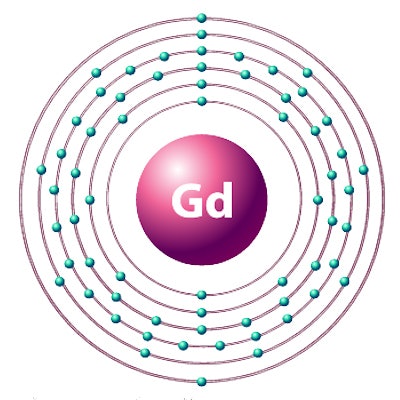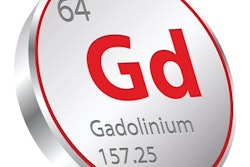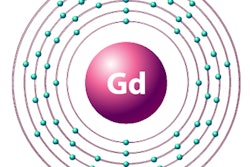
A study performed in mice has found that the amount of gadolinium retained in the brain after the administration of a gadolinium-based contrast agent (GBCA) depends heavily on whether the agent was linear or macrocyclic. The results were published May 22 in Radiology.
Researchers from France and Germany observed that as much as 75% of the total gadolinium detected in the cerebellum after the injection period is retained one year after the last injection of gadodiamide (Omniscan, GE Healthcare), a linear agent. By contrast, the researchers found no such retention with macrocyclic GBCA gadoterate (Dotarem, Guerbet).
"Further investigations are needed to characterize the nature of these macromolecules and to provide a better understanding of the putative risk associated with this gadolinium retention in the brain," wrote the researchers, led by Philippe Robert, PhD, from the department of research and innovation for the Guerbet Group.
Linear vs. macrocyclic
Over the last several years, a multitude of clinical and preclinical studies have found gadolinium retention is prominent in the cerebellum, especially in the dentate nuclei, and that gadolinium accumulation appears to be "more pronounced" with linear GBCAs than macrocyclic GBCAs, the authors noted. A July 2017 prospective animal study by McDonald et al was somewhat contrary to previous research, confirming the presence of gadolinium deposits in brain tissue after the injection of both linear and macrocyclic GBCAs.
The overriding question remains: What is the potential long-term effect of gadolinium deposition in brain tissue and at the molecular level, and does it vary by class of GBCA? While previous studies have documented the presence of gadolinium in brain tissue, these were either retrospective or looked at gadolinium deposition over short periods.
"[No] prospectively acquired data over very long periods are available in regards to the long-term behavior of gadolinium retained in the brain parenchyma, its forms, and the related T1 signal changes," Robert and colleagues wrote in the current paper. "For this purpose, we compared the gadolinium retention in rat brain in terms of kinetic and molecular forms for one year after repeated injections of the linear gadodiamide or the macrocyclic gadoterate meglumine."
Rat patrol
For this study, researchers took 140 nine-week-old rats and administered doses of gadolinium (2.4 mmol/kg body weight) once a week over a five-week period. The rats were divided into seven groups and followed for the next 12 months, with researchers performing T1-weighted MR imaging at seven time points -- one week, then at one, two, three, four, five, and 12 months -- after their last injection (Rad, May 22, 2018).
After sacrifice, brain and plasma samples were taken from autopsy to determine total gadolinium concentration by plasma mass spectrometry. More specifically, the researchers reviewed T1 hyperintensity for the cerebellum, left deep cerebellar nuclei, right deep cerebellar nuclei, and brain stem at one, three, five, and 12 months after the last injection. Additionally, they calculated MRI signal ratios between those four brain regions based on gadolinium quantification.
Macromolecular binding
The group found that according to several metrics for measuring gadolinium retention, there was more gadodiamide retained in the rats than gadoterate. For example, the gadodiamide group had gadolinium concentrations that exceeded background levels (0.07 nmol) for all time points recorded, and 75% of the gadolinium observed at the one-month point was retained at one year.
In addition, mean gadolinium concentration at one year for gadodiamide was 12- to 35-fold higher than gadoterate, the concentration of which had at that point faded to background levels. What's more, gadoterate was eliminated to background levels at the five-month mark of the study.
The study found higher concentrations of gadolinium at the one-year mark for gadodiamide versus gadoterate regardless of brain region, as indicated in the table below:
| Retention of gadolinium in brain, gadoterate vs. gadodiamide | ||
| Mean gadolinium concentration at 1 year, by brain region | Gadodiamide | Gadoterate |
| Cerebellum | 2.45 nmol | 0.07 nmol |
| Cortical brain | 1.23 nmol | 0.09 nmol |
| Subcortical brain | 1.52 nmol | 0.05 nmol |
| Brain stem | 0.74 nmol | 0.06 nmol |
"In conclusion, a large portion of gadolinium was retained after repeated administration of the linear GBCA gadodiamide in our study, with binding of soluble gadolinium to macromolecules," Robert and colleagues wrote.
They added that further research is needed to "characterize the nature of these macromolecules and to provide a better understanding of the putative risk associated with this gadolinium retention in the brain. After repeated injections of the macrocyclic GBCA gadoterate, only traces of the intact chelated gadolinium were observed, with time-dependent clearance."
In perspective
The findings by Robert and colleagues that there is an increasing concentration of gadolinium from a linear GBCA adheres to macromolecules in the cerebellum over time promoted an accompanying commentary from Dr. Alexander Radbruch, JD, head of neuro-oncologic imaging at the German Cancer Research Center in Heidelberg and University Hospital Essen, and a leading gadolinium researcher (Rad, May 22, 2018).
 Dr. Alexander Radbruch from Heidelberg University.
Dr. Alexander Radbruch from Heidelberg University.The difference between linear and macrocyclic GBCAs is based on how the ion of gadolinium binds to a ligand to create the contrast agent. The bonds also allow the contrast agent to be expelled from the body after an MRI scan with no residual gadolinium left behind in a process known as chelation. However, some researchers postulate that the connection somehow breaks down in linear GBCAs through dechelation and allows gadolinium to remain in patients.
"The current study provides further evidence that gadolinium deposition in the brain needs to be specified as either deposition of the intact chelate that is eliminated over time for both linear and macrocyclic GBCAs, or as potentially permanent dechelated gadolinium deposition that is caused exclusively by linear GBCAs," Radbruch wrote in his editorial.
Radbruch was quick to warn that the study investigates only one linear GBCA and one macrocyclic GBCA, and conclusions should be drawn individually for all GBCAs in use.
"At the current stage of the debate, it is extremely important to emphasize that despite the enormous number of GBCA injections, no clinical correlates are known and that any unreasonable decline of GBCAs in clinically indicated situations should be avoided," he added. "Nevertheless, we should remind ourselves that chelated GBCAs are injected because we thought they would be excreted over time and not dechelate in vivo."



















